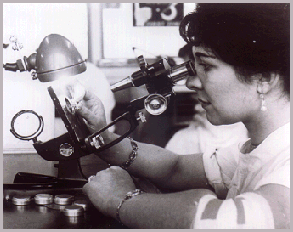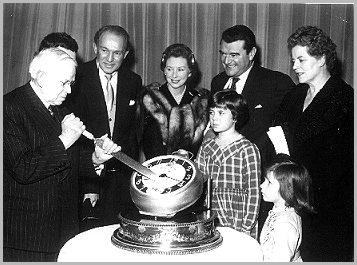
The Visitor 7
Conclusion
Inspection of watch movements under the microscope
 As
soon as it is moving, each movement undergoes a further strict
inspection. Then follows a test on a rate recorder and the critical
adjustments that every new timekeeper must have to make it dependable
and correct. With these done, it passes to join a batch of similar
movements for its first running test. For this it is mounted
on slowly revolving drums that test its performance in many positions
for 24 hours. When this check is surmounted satisfactorily, there
comes the fitting of dial, hands and then the assembly into its
case, which has come from the other Ystradgynlais factory, only
a few yards away.
As
soon as it is moving, each movement undergoes a further strict
inspection. Then follows a test on a rate recorder and the critical
adjustments that every new timekeeper must have to make it dependable
and correct. With these done, it passes to join a batch of similar
movements for its first running test. For this it is mounted
on slowly revolving drums that test its performance in many positions
for 24 hours. When this check is surmounted satisfactorily, there
comes the fitting of dial, hands and then the assembly into its
case, which has come from the other Ystradgynlais factory, only
a few yards away. It can only be said that, at Gurnos Works, a really sincere attempt is made to produce reliable pin-pallet lever watch movements in the best way that modem horological manufacturing techniques render possible.
"Horological Journal"
January 1963
(left to right)
Mr E.S. Daniels (founder of
British Ingersoll), Mr Patrick Barr, Mrs Jack Hawkins, Mr Jack
Hawkins and Miss Joan Gilbert with the daughters of Mr Bernard
Braden and Miss Barbara Kelly
